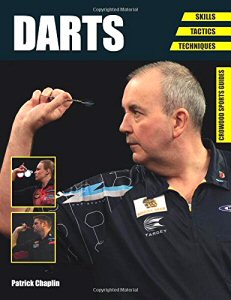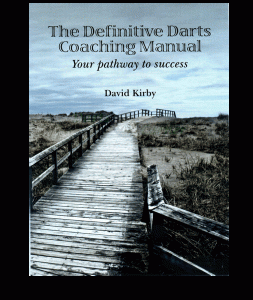Bookreviews
How-to Manuals
Patrick Chaplin: Darts. Skills, Tactics, Techniques
Ramsbury: The Crowood Press Ltd, 2015
Crowood Sports Guides
ISBN 978-1-78500-005-8
 Once again Patrick Chaplin put his pen to paper and wrote a new book, which was now published by Crowood Press as part of the series Crowood Sports Guides.
Once again Patrick Chaplin put his pen to paper and wrote a new book, which was now published by Crowood Press as part of the series Crowood Sports Guides.
The with many pictures - mostly photographs - appealingly arranged book has 96 pages and is subdivided into three parts: An Introduction into the Game, Skills and Techniques und Developing Your Game. Of course a book written by Dr. Patrick Chaplin will not get on without any bearing to the history of the sport and you can't write an introduction into the sport without including the history. So the book imparts the necessary background knowledge and explodes several popular myths. But preponderant the book is a darts praxis book which will help the players to improve their skills and abilities. And so Chaplin leads the reader step by step based on the 501 game from the selection of the right equipment, the basics of the game including the most important rules to increased performance and more interesting practice sessions. At the end of the book one can find an overview over the - for Patrick Chaplin - really helpful accessories (might be like the whole book a little bit too much Winmau - there to be sure are some other manufacturers), relevant addresses and a glossary.
Even though Dr. Patrick Chaplin built up his reputation mostly as an expert for darts history, he is as a long time dartsplayer and good acquaintance of many top players a man of practical darts experience as well. And thus with this sports guide he has added another well-made book which especially gives the beginners a good understanding of the sport and which looks at many things from a different and new angle.
David Kirby: The Definitive Darts Coaching Manual: Your pathway to success
Anchorprint Group Limited, 2012.
ISBN 978-1-907540-54-7
 "The Definitive Darts Coaching Manual"is a thin booklet of 70 pages which was published in 2012 by Anchorprint Group Limited. By now the second edition is on the market and a Kindle edition is available too. One can buy it at amazon.de, the price is 5 pound. The book come with a recommendation by Jamie Caven, just now David Kirby writes a book over Caven.
"The Definitive Darts Coaching Manual"is a thin booklet of 70 pages which was published in 2012 by Anchorprint Group Limited. By now the second edition is on the market and a Kindle edition is available too. One can buy it at amazon.de, the price is 5 pound. The book come with a recommendation by Jamie Caven, just now David Kirby writes a book over Caven.
David Kirby was so kind to give me a copy to write a review.
David Kirby has a lot of experience as a coach for athletics and martial arts. He plays darts himself and manages County and Super league teams, which connected him to Jamie Caven. To background knowledge is important to really understand the book. Kirby writes that the book is aimed at the majority of players, but I doubt it really helps an absolute beginner or that an experienced professional will find a lot of really new ideas in it.
In many parts the suggestions are - as it almost can be expected with such a "slim" book - kept rather short. Kirby certainly is right when he writes how important it is to keep the emotions under control in competition and not to give away anything by body language, but he doesn't elaborate the necessary: "How do I manage that?" Kirby's assessment that it needs 9000 hours of meaningful practice over 6 years to give you the chance to become a good player is interesting but again you can't find a real explanation why that is the case and what meaningful practice would be.
In some parts the approach looks promising but the development is not convincing. Goal setting really is big points in darts but what Kirby suggests are outcoming goals one shouldn't set because they only lead to frustration and tend to dispirit and they are in no way helpful planning a practice strategy either. That of course then drops in into Kirby's detailed practice sessions. Planned practice sessions are not only useful but necessary but should include more then Kirby's attractive switch and hours of not performance enhancing throwing at the triple 20 or the Bullseye.
Really good is Kirby's extensive finishing chapter which includes his "Infamous Ten". And it's very welcome he covers the know-how of chalking in his book, probably he his experience in league showed him some tutoring would be a good idea.
It's very positive to see more and more people try to help dart players along now-a-days. Each new release brings new impulses and new points of view. It's not different with David Kirby's book. It wouldn't be fair to compare such a thin "first work" with the matured concept of the American "Flight School" by George Silberzahn, who like Kirby came from league play and his work with league players, or the convincing coherent work of the Darts Performance Centre which is based on the latest perceptions of sports science and sports psychology, which both have the additional advantage of interactivity. Kirby had announced he'll publish a series of books on the same subject and I am curious to find out where his path will lead him.
"The Definitive Darts Coaching Manual" alone offers no real alternative.
Patrick Chaplin: "The Official Bar Guide to Darts"
New York: Sterling Publishing Co, 2010.
ISBN 978-1-4027-5524-8
 Patrick Chaplin's new book "The Official Bar Guide to Darts" published in June 2010 is for me in several respects a surprising book.
Patrick Chaplin's new book "The Official Bar Guide to Darts" published in June 2010 is for me in several respects a surprising book.
For the first time I was surprised when I got it - it is a rather small and a rather thin book, really a pocket-book. I had thought it to be bigger.
When reading it I was two more times surprised, first because for me Patrick Chaplin is more some kind of darts theoretician not really a playing expert. But without a problem he's able to give sound statements about the practical side of the sport.
And the second positive surprise while reading was that he really manages it on just 182 sides to address all aspects of the sport. He even includes a short history of darts in England and America and a detailed chapter with games for more or less all occasions.
Of course one can object that for example the topic "practice" would need more room to get to the bottom of the matter and some topics it would do no harm to get more room.
Very critical readers like me will probably find a few mistakes like that John Part didn't win his first PDC World Champion title in 2001 as mentioned here but in 2003 or that the NAODT can't be an important tournament today because it stopped to exist in 2000 but those don't diminish the good general impression.
Patrick Chaplin even managed it to squeeze in an appendix full of useful things like an Outshot Chart and a Darts Glossary.
The book really turned out well, it is easy to understand and it covers the sport- it can only be recommended to all people interested in darts.
One can buy it at amazon.de
George Silberzahn: Darts Beginning to End.
o.O: Xlibris Corporation, 2009
ISBN 978-1-4415-3871-0

This is the third book George Silberzahn did publish and I would say it's the best so far.
In some way the three books develop one out of the preceding- so by now we've got the most extensive, best
developed and most up-to date version.
The focal point of all three books is to help dartplayers of all skill levels to get better and to enjoy themselves more playing darts.
The method George uses for that is called "Flight School" and it's all his own idea. "Flight School" one could describe as a course
of practice drills and mental practice for dartplayers of all levels with a totally new philosophy.
Grouped around this you can find chapters about soft-tip specifics, the always relevant topic "slump", games, the ideal
American Dartleague, an updated version of "Legends speak" which now includes the actual North American Top Players,
Potential Legends and Tournament Directors.
I am well acquainted with Flight School - so it's not really new for me but what I did find fascinating are the discussions
between George and Flight School participants about certain points. You can almost watch George how he integrates the results
of the discussions into his "Flight School" to get rid of might be misunderstandings and flaws and somehow one can well
imagine that though the "Flight School" by now really is a "mature" and proven training course there still could be changes
and improvements should it turn out someone has got good enough arguments for this.
The book is neither dry nor boring at all what can happen with such a kind of book but Georges writing style is rather
vivid anyway and the discussions and the statements in the second part of the book do one more thing to make it readable and easy to understand.
I can only recommend this book - it really is a book that can help you on and for all who already take part in "Flight School" it's
nevertheless interesting to read because of the discussions and the additional chapters and in the end because it's necessary from
time to time to remember all the details which one tends to forget as time drew on.
One can buy the book either from George Siberzahn's homepage:
www.howtodarts
or from the publisher:
www.xlibris.com
The hardback version costs $29.99 , the paperback $ 19.99